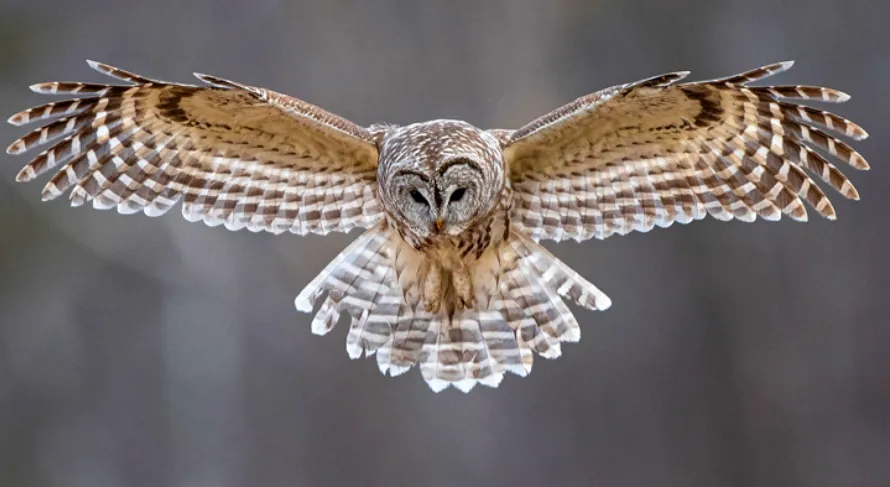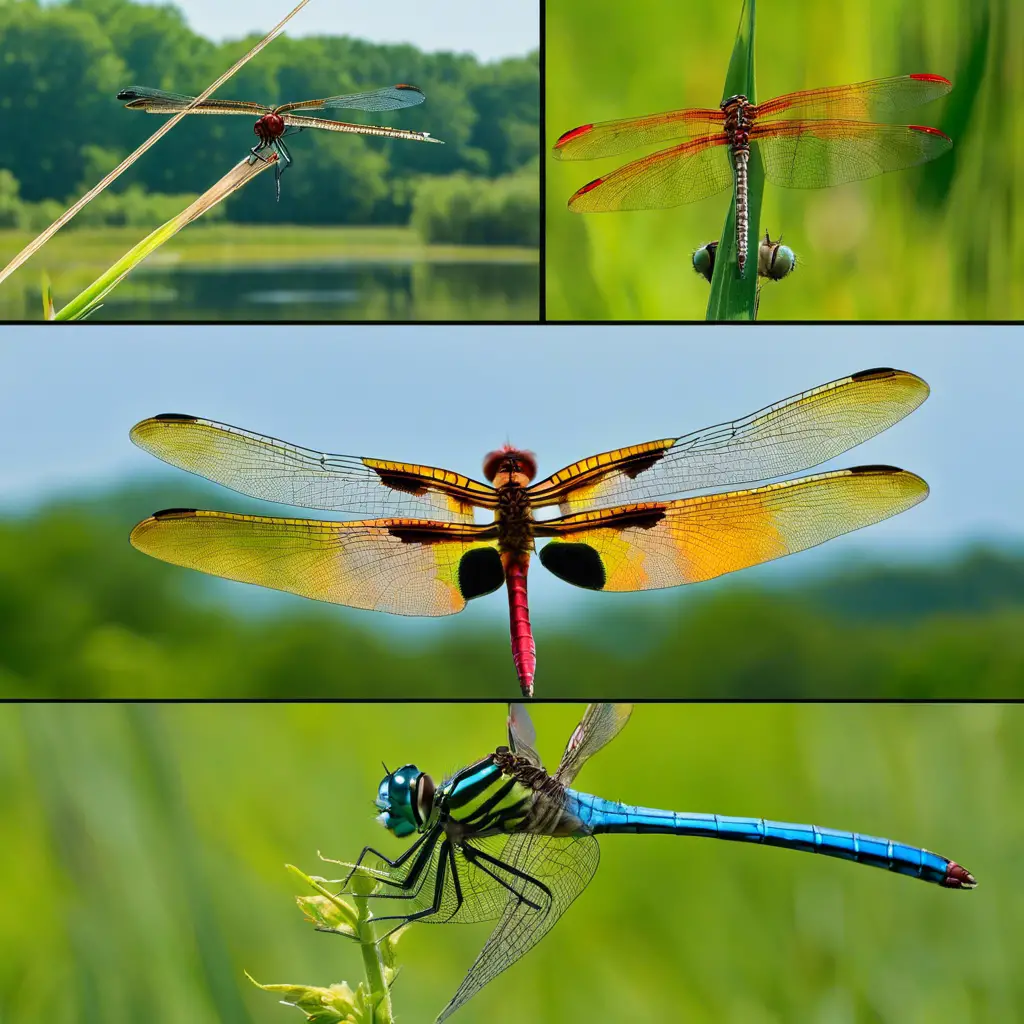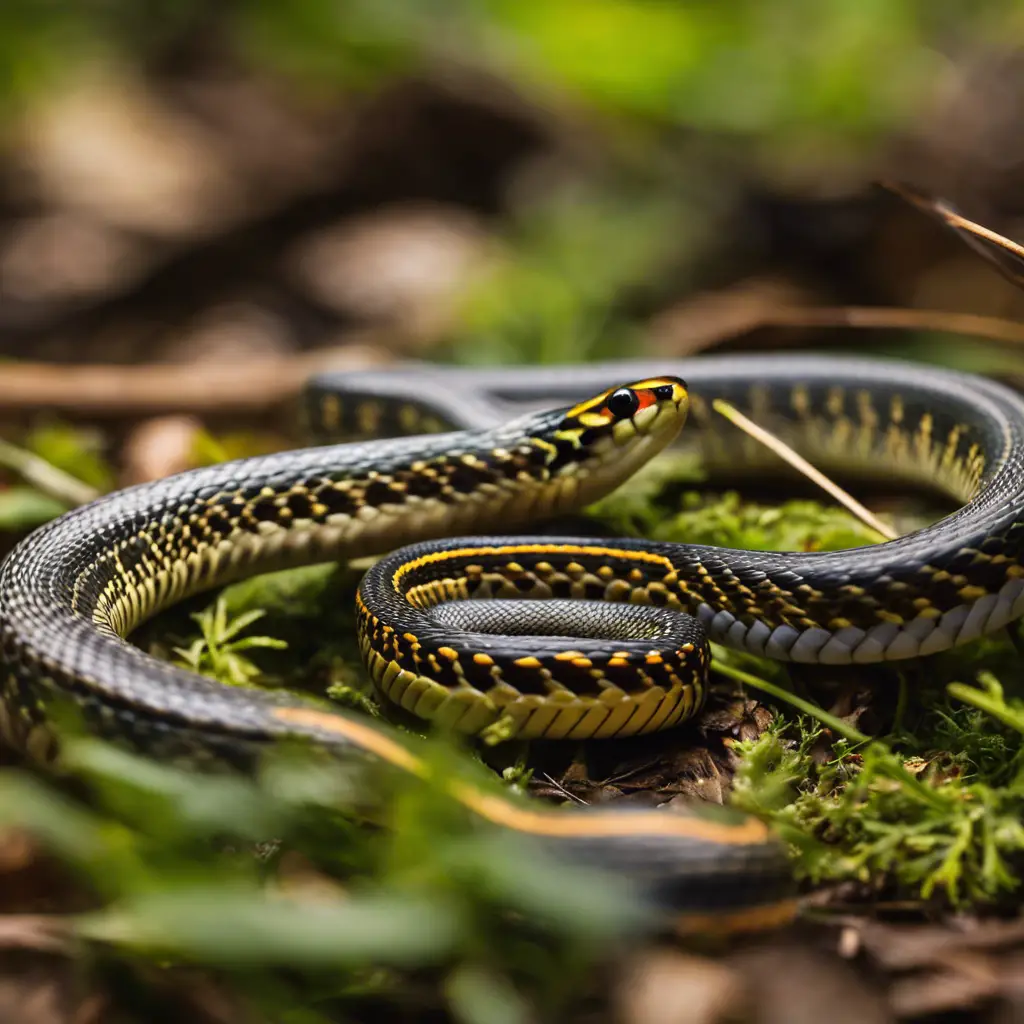You’ll be amazed by the diverse owl species that call Ohio home. From the small Eastern screech-owl to the majestic Great horned owl, these fascinating creatures inhabit our forests and woodlands.
With their keen eyesight and incredible hunting skills, owls play a crucial role in maintaining the balance of nature.
In this article, we’ll explore the different owl species found in Ohio, their behaviors, and their important ecological contributions.
Get ready to discover the enchanting world of owls in Ohio!
Key Takeaways
- Ohio is home to a variety of owl species, including the Eastern Screech-Owl, Barred Owl, Great Horned Owl, Long-eared Owl, and Short-eared Owl.
- These owl species inhabit various habitats in Ohio, ranging from forests to urban areas, with preferences for specific types of vegetation and roosting sites.
- Conservation measures for specific owl species include protecting and creating suitable habitats, preserving nesting sites, addressing habitat loss and degradation, and conducting research and monitoring programs.
- Other owl species found in Ohio include the Great Gray Owl, Flammulated Owl, Western Screech-Owl, Whiskered Screech-Owl, and Mexican Spotted Owl, with conservation efforts focusing on habitat preservation and monitoring population trends.
Eastern screech-owl
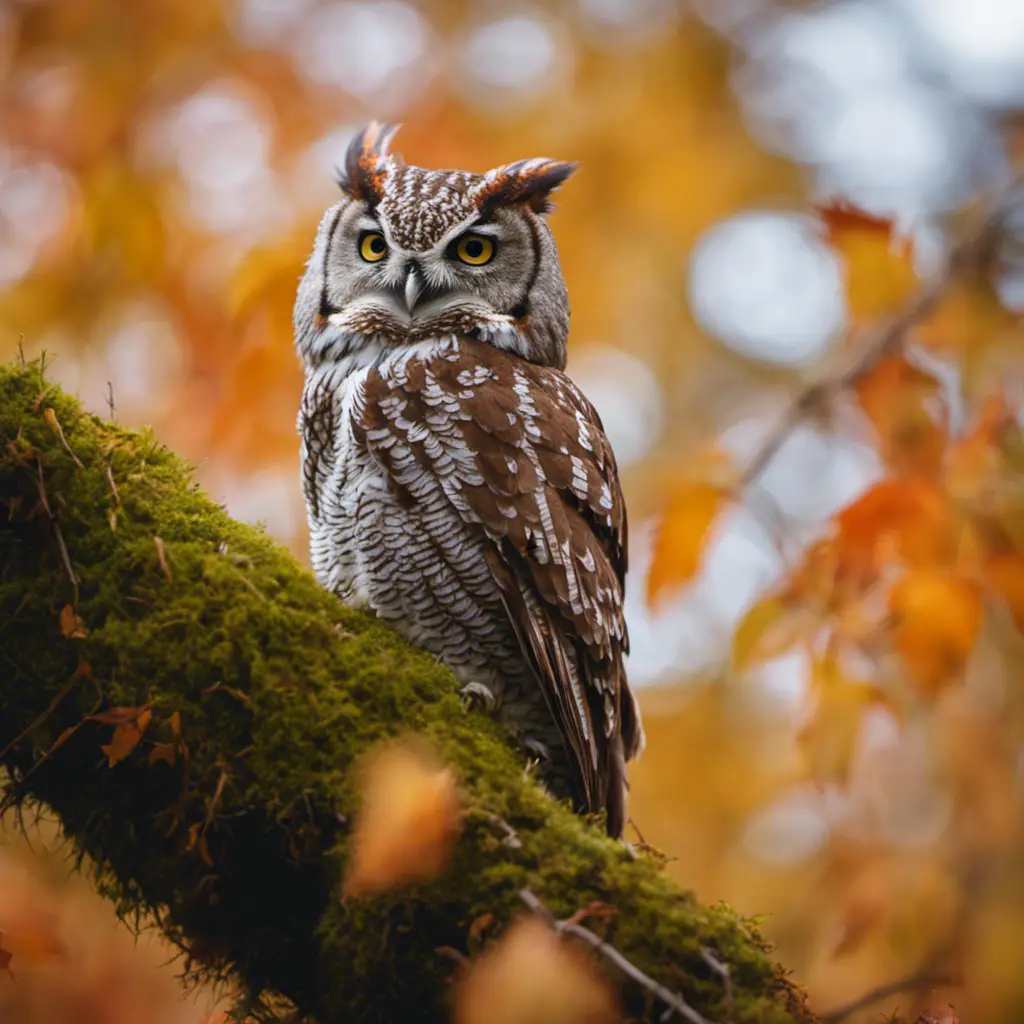
You should learn about the Eastern screech-owl because it’s a fascinating nocturnal bird.
The Eastern screech-owl, scientifically known as Megascops asio, is commonly found in the eastern parts of North America, including Ohio. It inhabits various types of woodland habitats, such as deciduous forests, coniferous forests, and mixed forests. This adaptable owl can also be found in suburban areas with suitable vegetation.
Hunting primarily at night, the Eastern screech-owl feeds on a diverse diet consisting of small mammals, birds, insects, and even amphibians.
Conservation efforts have been implemented to protect the Eastern screech-owl and its habitat, as its population has been experiencing declines in some areas. By preserving suitable habitats and raising awareness about the importance of these owls, we can contribute to their long-term survival.
Barred owl
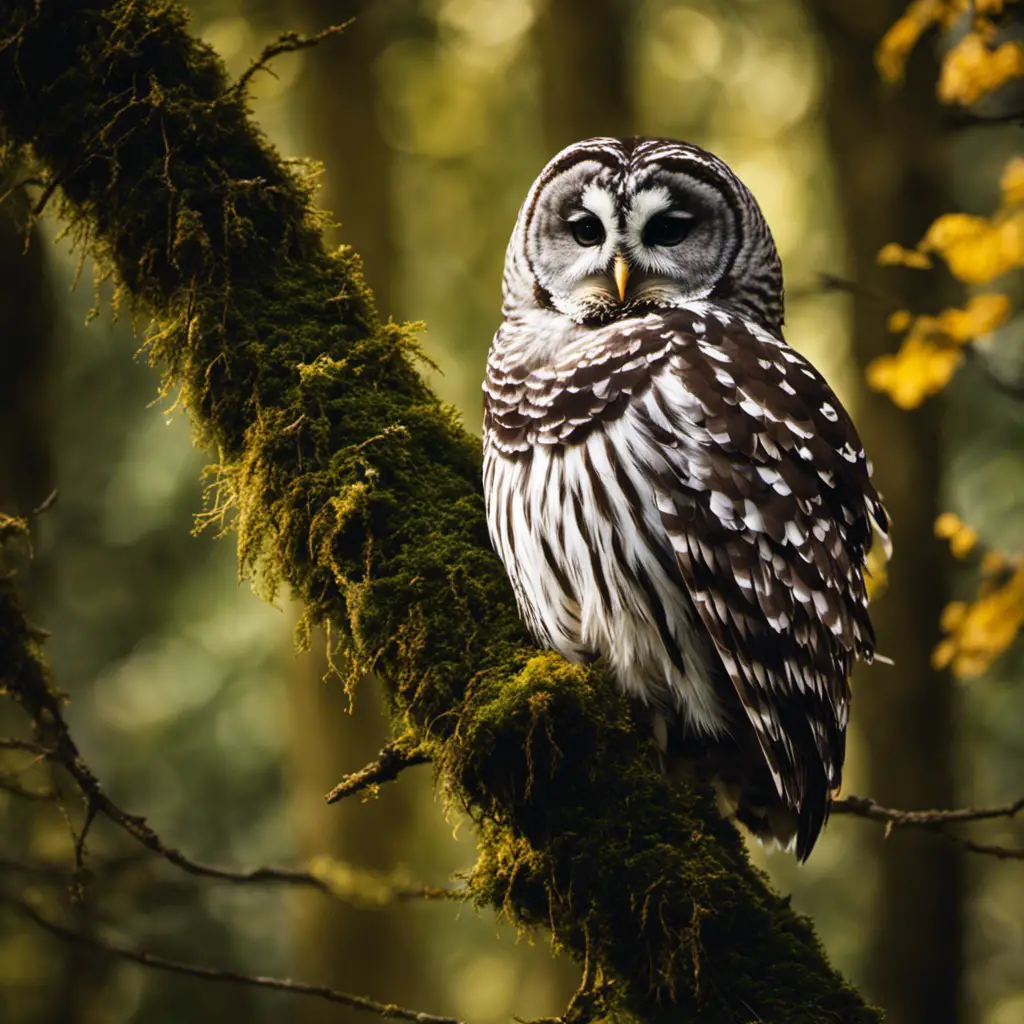
Learn about the barred owl, as it’s known for its distinct hooting sound and is commonly found in Ohio.
The barred owl (Strix varia) is a medium-sized owl with a wingspan of around 3 feet. It has a stocky build, large dark eyes, and a rounded head with no ear tufts.
This species primarily inhabits deciduous and mixed forests, where it can find suitable nesting sites and prey. However, habitat loss due to deforestation poses a significant threat to their population. Conservation efforts are underway to protect and restore their habitats.
Key Points:
Barred owls have a distinctive ‘who-cooks-for-you, who-cooks-for-you-all’ call that can be heard throughout their territory.
They’re opportunistic hunters and feed on a variety of prey, including small mammals, birds, amphibians, and invertebrates.
Barred owls are known for their ability to hunt in low light conditions and can even locate prey underneath the snow using their excellent hearing.
Great horned owl
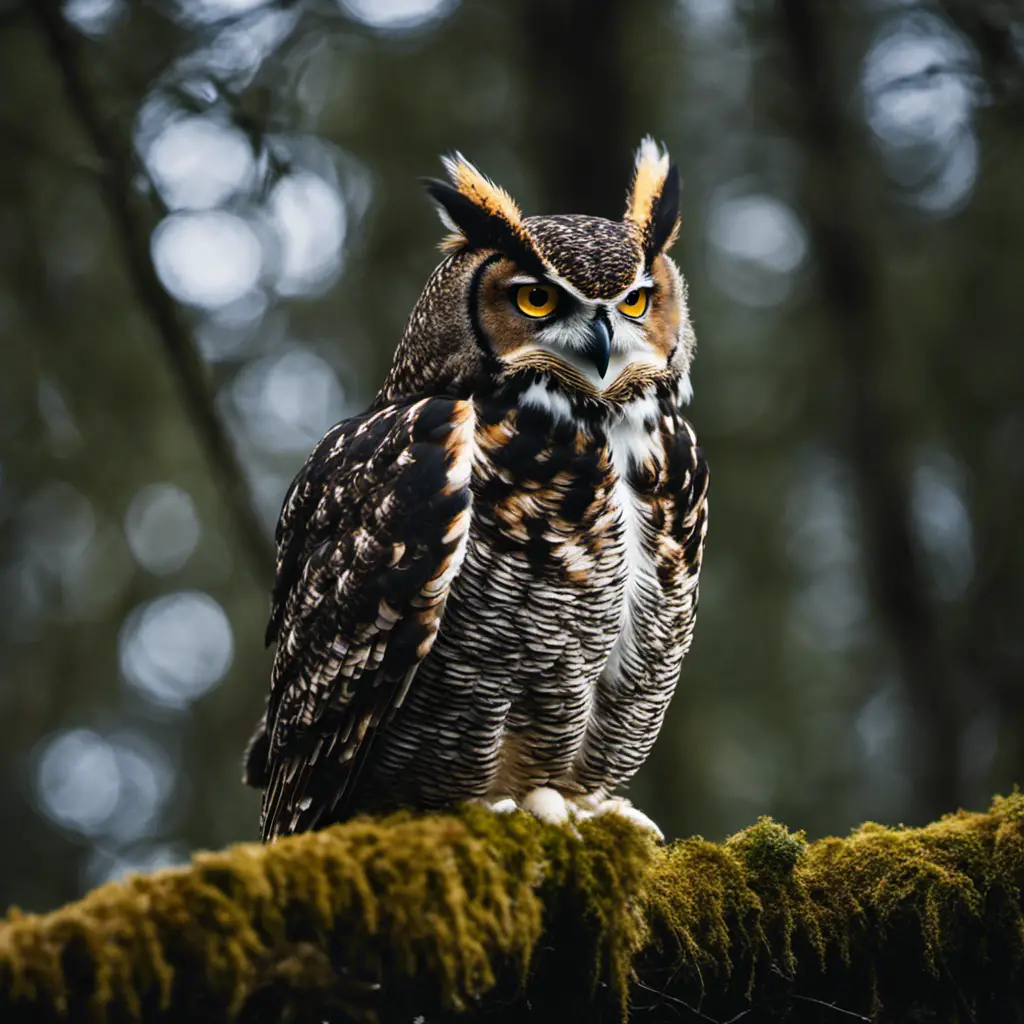
If you look closely, you might spot a great horned owl perched high in the trees, as they’re known for their distinctive tufted ears and powerful hunting abilities. The great horned owl, scientifically known as Bubo virginianus, is one of Ohio’s most common owl species.
These magnificent creatures can be found throughout the state, from forests to urban areas. With their large size and prominent ear tufts, great horned owls are easily recognizable. They’ve sharp talons and a strong beak, making them skilled hunters capable of capturing a wide range of prey, including small mammals, birds, and even reptiles.
Another owl species found in Ohio is the Eastern screech owl, known for its small size, camouflage plumage, and distinct trilling call. Both species play important roles in the ecosystem, helping to control populations of rodents and other small animals.
Long-eared owl
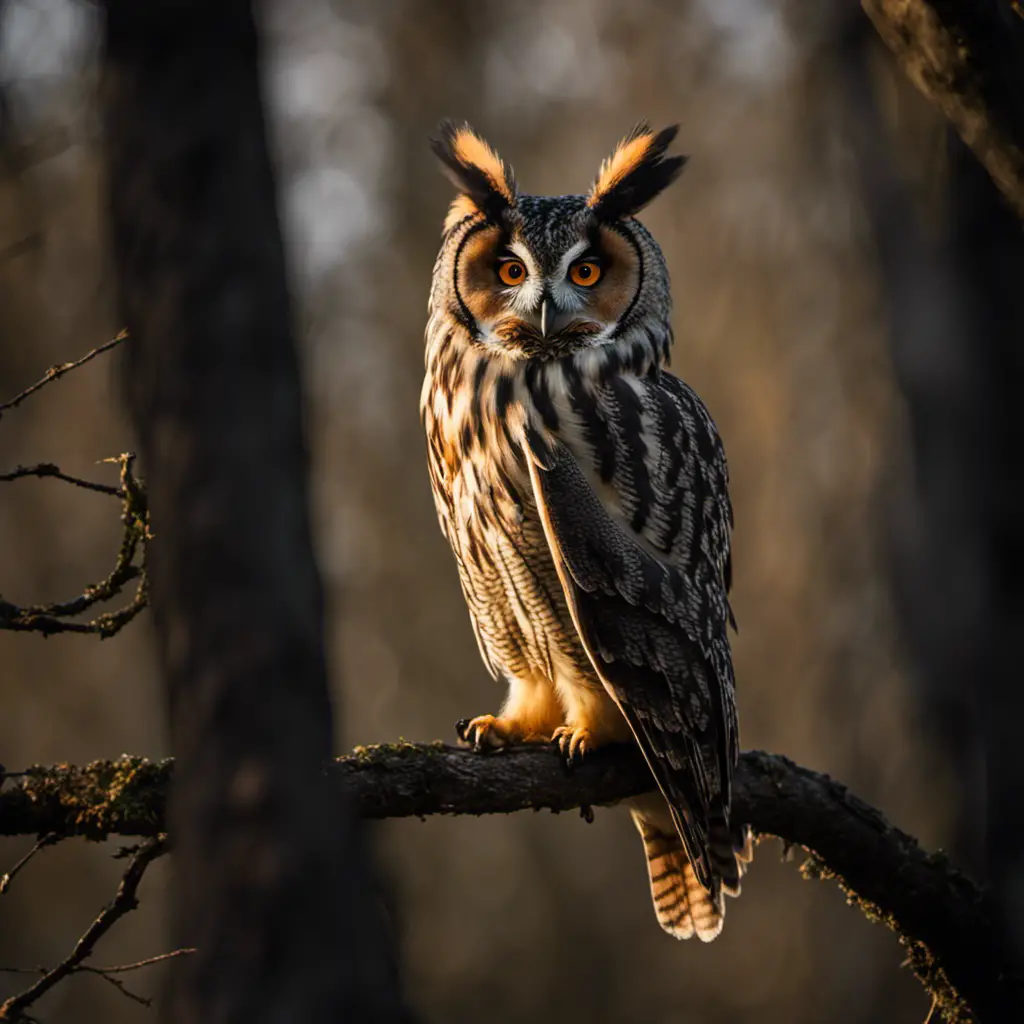
Spotting a long-eared owl can be a challenge, but if you listen carefully and scan the trees, you might just catch a glimpse of its distinctive ear tufts and silent flight. Long-eared owls are medium-sized birds with a wingspan of up to 39 inches. They have excellent camouflage, often blending in with their surroundings.
Here are some key points about their hunting habits and habitat preferences:
Hunting habits:
Long-eared owls are primarily nocturnal hunters, using their exceptional hearing to locate prey.
They mainly feed on small mammals, such as mice and voles, but also consume birds and insects.
These owls are skilled hunters, silently swooping down on their prey from perches or in mid-flight.
Habitat preferences:
Long-eared owls prefer dense forests, woodlands, and marshes where they can find suitable roosting and nesting sites.
They often choose areas with a mix of open spaces and dense vegetation, providing a variety of hunting opportunities.
These owls are known to migrate during the winter months, moving to more southerly regions in search of food.
Understanding the hunting habits and habitat preferences of long-eared owls can help us appreciate and protect these magnificent birds in our natural ecosystems.
Short-eared owl
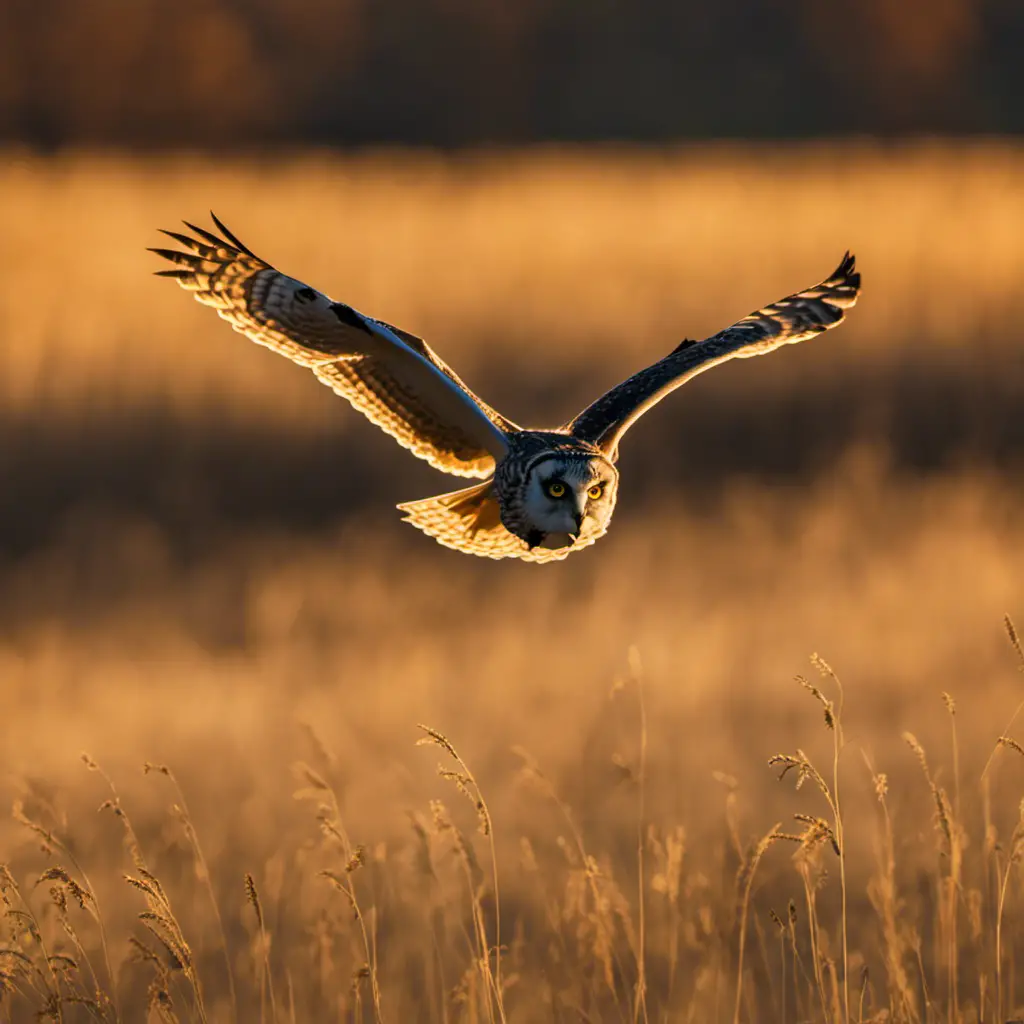
You can observe the short-eared owl hunting during the day, as they use their keen eyesight and agile flight to catch small mammals and birds.
Short-eared owls are known for their unique hunting behavior, as they prefer to hunt in open grasslands and marshes. They rely on their excellent hearing to locate their prey, and then silently swoop down from above to catch it with their sharp talons.
These owls have a preference for habitats with low vegetation, as it allows them to easily spot their prey and maneuver through the area. Their hunting behavior isn’t restricted to nighttime like most owls, making them a fascinating species to study.
The short-eared owl’s ability to adapt to different habitats and hunt during the day showcases their remarkable survival skills.
Northern saw-whet owl
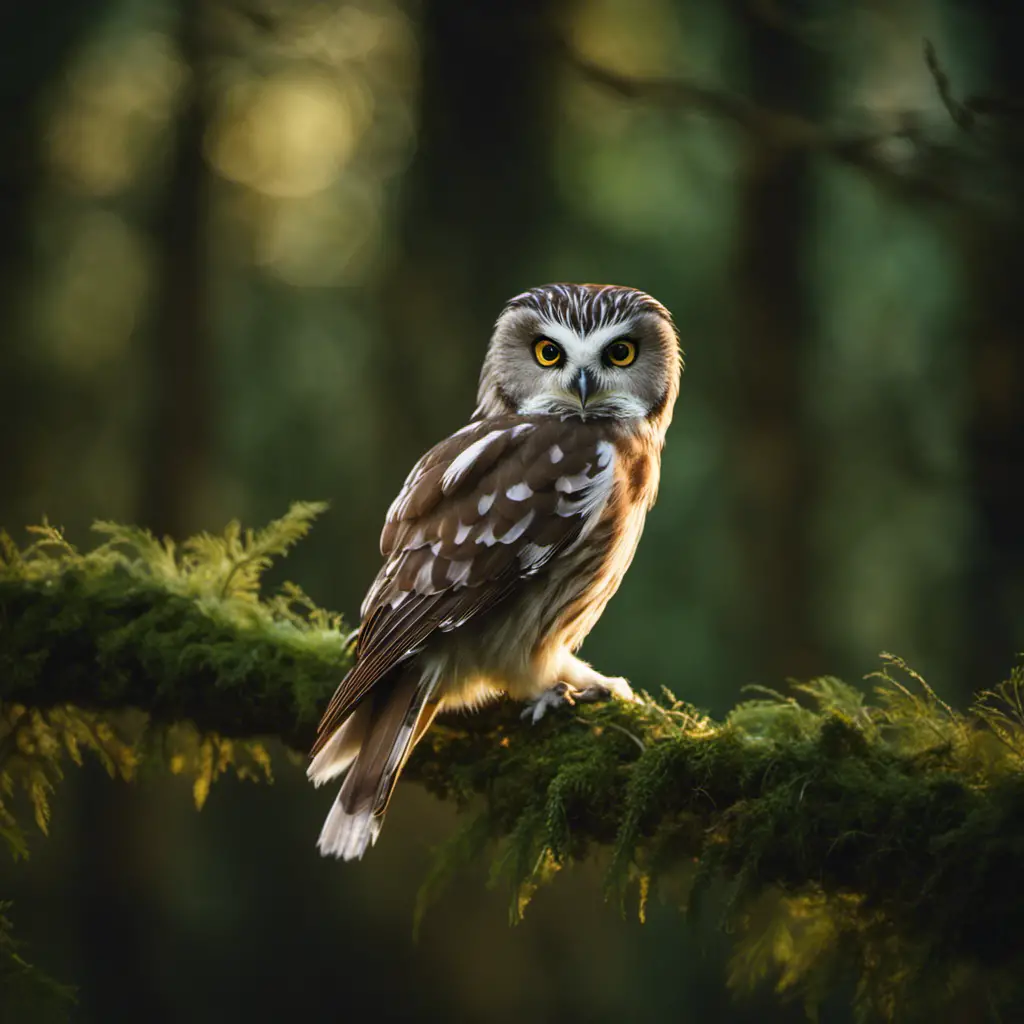
You can easily identify the Northern saw-whet owl by its small size and distinct call, and it’s often found in dense forests.
This species of owl is known for its migratory patterns, as it travels long distances during the winter months. Conservation efforts are crucial in protecting the Northern saw-whet owl population. Here are three key points to consider:
Migratory patterns: The Northern saw-whet owl migrates from its breeding grounds in Northern Canada and Alaska to southern parts of the United States during the winter. This long-distance journey requires suitable stopover habitats along the way, where they can rest and refuel.
Conservation efforts: To ensure the survival of the Northern saw-whet owl, conservation measures focus on preserving its breeding and stopover habitats. This includes protecting old-growth forests and creating suitable nesting sites.
Research and monitoring: Scientists conduct research and monitoring programs to better understand the Northern saw-whet owl’s population dynamics, habitat requirements, and migration patterns. This information helps guide conservation efforts and informs management strategies.
Barn owl
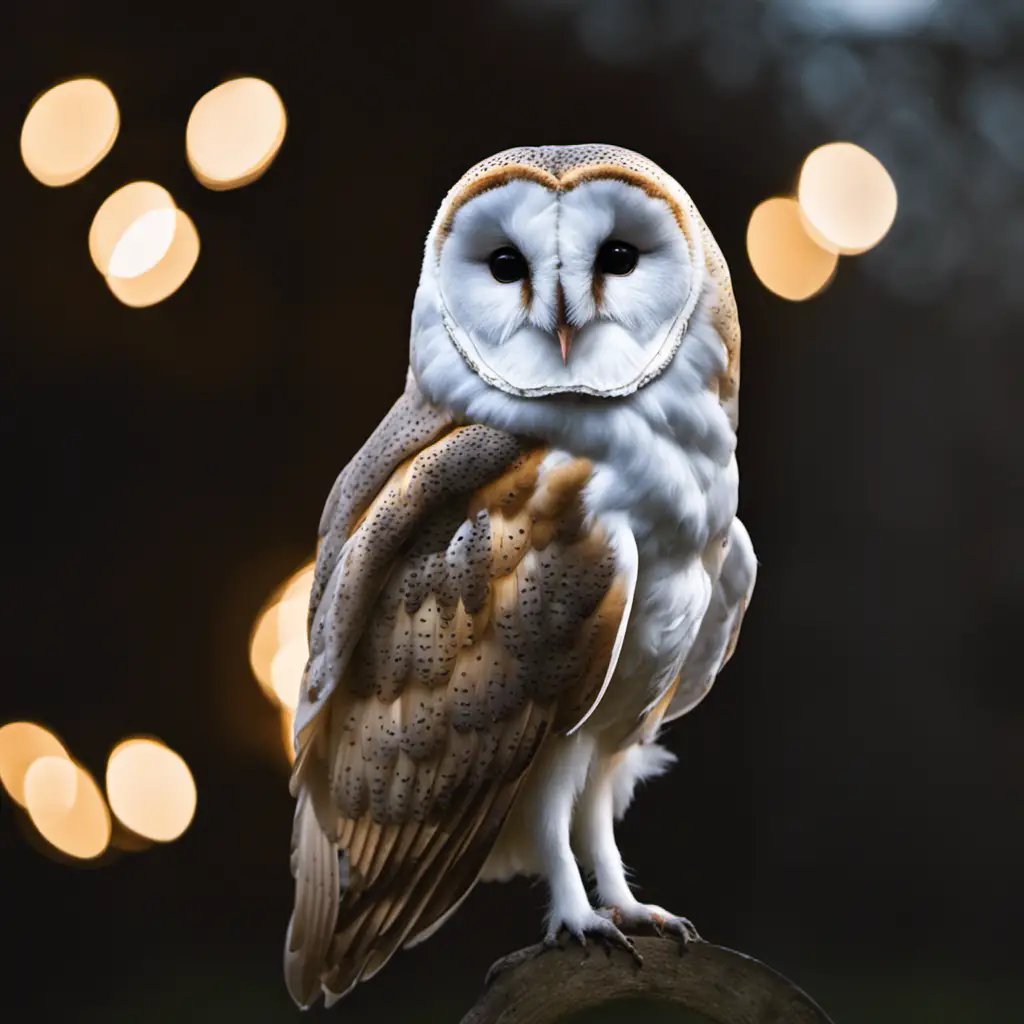
Interestingly, the barn owl, with its distinctive heart-shaped face, is known for its exceptional hunting skills and ability to fly silently. Barn owls are found in various habitats across the world, including grasslands, farmlands, and even urban areas. However, habitat loss and degradation have led to a decline in their population, making barn owl conservation efforts crucial.
Barn owls require specific habitat requirements to thrive. They prefer open areas with ample prey availability, such as rodents and small mammals. These nocturnal hunters rely on suitable nesting sites, such as barns, abandoned buildings, and tree cavities. Conservation efforts focus on protecting and creating suitable habitats for barn owls, including providing nesting boxes and preserving existing nesting sites.
Snowy owl
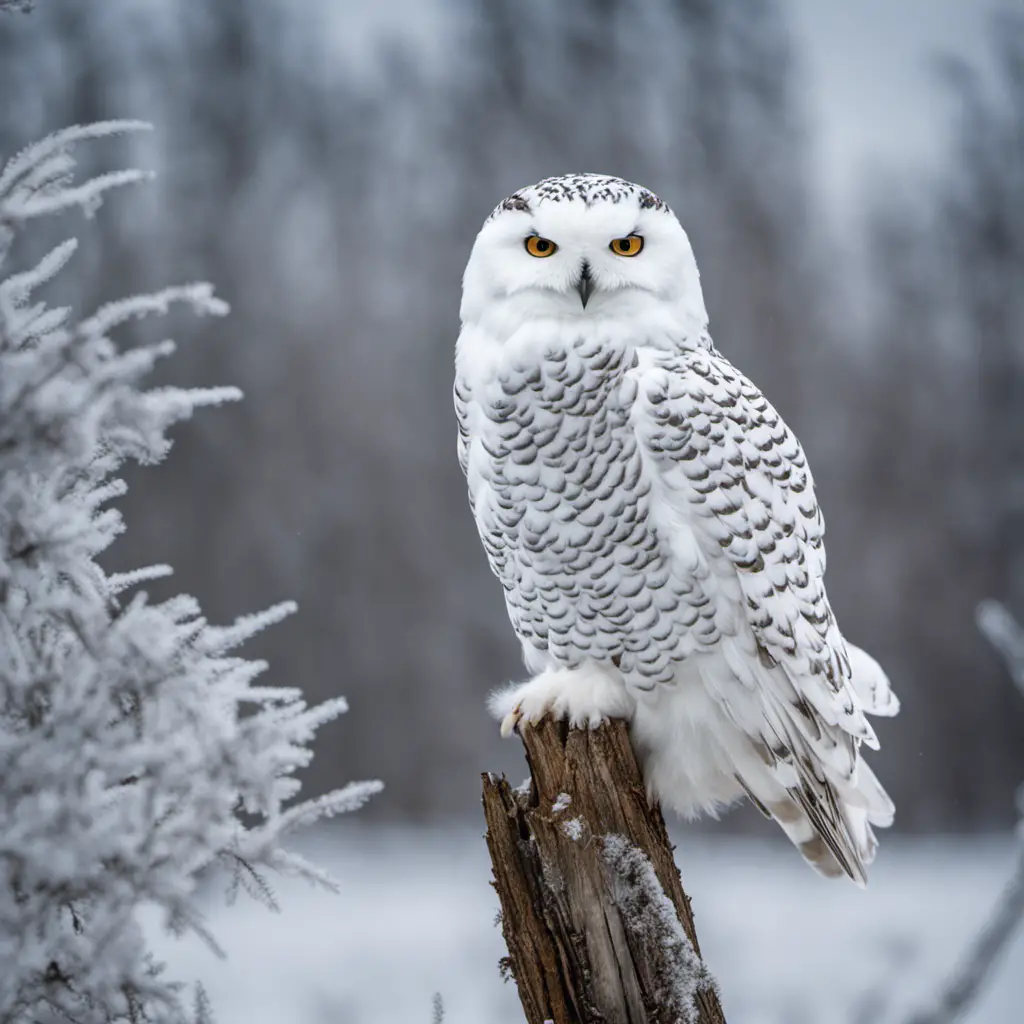
The snowy owl is a magnificent bird that inhabits the Arctic tundra and is known for its ability to survive in extremely cold temperatures. These striking birds have unique migration patterns that span vast distances.
Here are three important aspects of snowy owl migration patterns:
Seasonal movements: Snowy owls are considered partial migrants, meaning that not all individuals migrate. However, those that do undertake long-distance journeys from their breeding grounds in the Arctic to more southerly regions during the winter months.
Irregular irruptions: Snowy owl migration patterns are influenced by food availability. In certain years, when their primary prey, lemmings, experience population fluctuations, snowy owls may irrupt and move southward in search of food.
Individual variations: Not all snowy owls migrate the same way. Some individuals may travel hundreds or even thousands of kilometers, while others may stay closer to their breeding grounds.
Snowy owl conservation efforts are crucial to ensure the survival of these magnificent birds. Conservation initiatives focus on protecting their breeding and wintering habitats, reducing disturbance, and promoting awareness among communities to minimize human impact. By understanding their migration patterns and implementing effective conservation strategies, we can help protect the snowy owl population for future generations.
Burrowing owl

Don’t underestimate the intelligence of a burrowing owl; their resourcefulness and adaptability make them fascinating creatures to study.
In Ohio, burrowing owls face unique challenges due to habitat loss and degradation. Conservation efforts are underway to protect and restore their habitats.
Burrowing owls are small, ground-dwelling birds known for their distinctive facial expressions and behavior. They’re primarily active during the day and rely on their keen eyesight and hearing to hunt for insects and small mammals. These owls build their nests in underground burrows, often reusing abandoned burrows of other animals.
Habitat restoration projects aim to create suitable nesting sites by providing open areas with short vegetation and sandy soils. By preserving and improving their habitats, we can help ensure the survival of these remarkable owls in Ohio.
Northern pygmy-owl
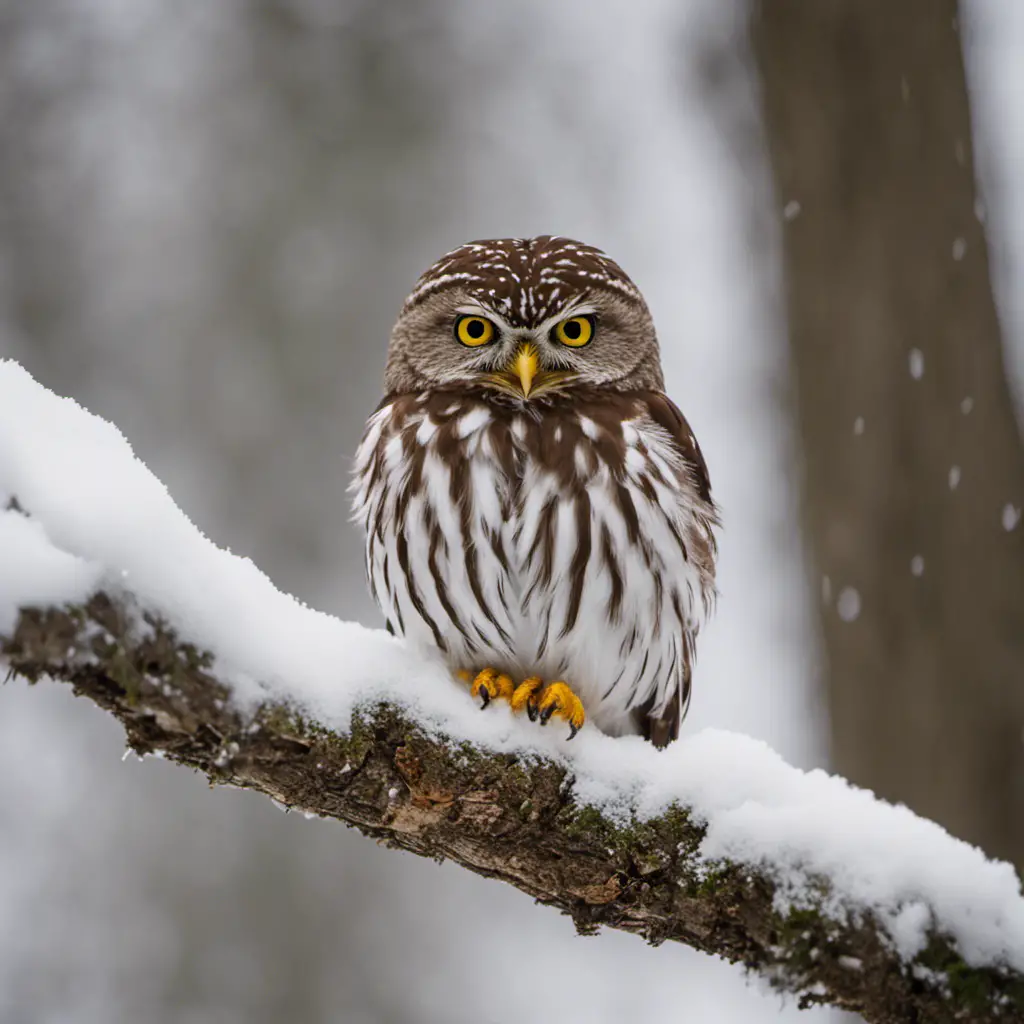
You can often spot the elusive northern pygmy-owl perched on tree branches, waiting patiently for its prey. This small owl, measuring around six inches in length, is native to the forests of Ohio.
Here are a few key points to understand about the habitat and behavior of the northern pygmy owl in Ohio:
Habitat: The northern pygmy owl prefers mature forests with dense vegetation, including conifers such as pine and spruce. These trees provide suitable nesting sites and abundant prey, such as small birds and mammals.
Behavior: This owl is primarily active during the day, unlike most other owl species. It hunts by silently gliding from tree to tree, using its excellent vision and hearing to locate its prey. It’s known for its distinctive bobbing motion and its ability to mimic the calls of other birds.
Conservation efforts for the northern pygmy owl in Ohio are essential to protect its habitat and ensure its survival. Some conservation strategies include:
Protecting and preserving mature forests: By conserving the natural habitat of the northern pygmy owl, we can ensure that it has suitable nesting sites and ample prey.
Controlling the spread of invasive species: Invasive plants and animals can disrupt the balance of the ecosystem and negatively impact the northern pygmy owl’s food sources. Implementing measures to control and manage invasive species is crucial for its conservation.
Educating the public: Raising awareness about the importance of conserving the northern pygmy owl and its habitat can encourage individuals to take action and support conservation efforts.
Boreal owl
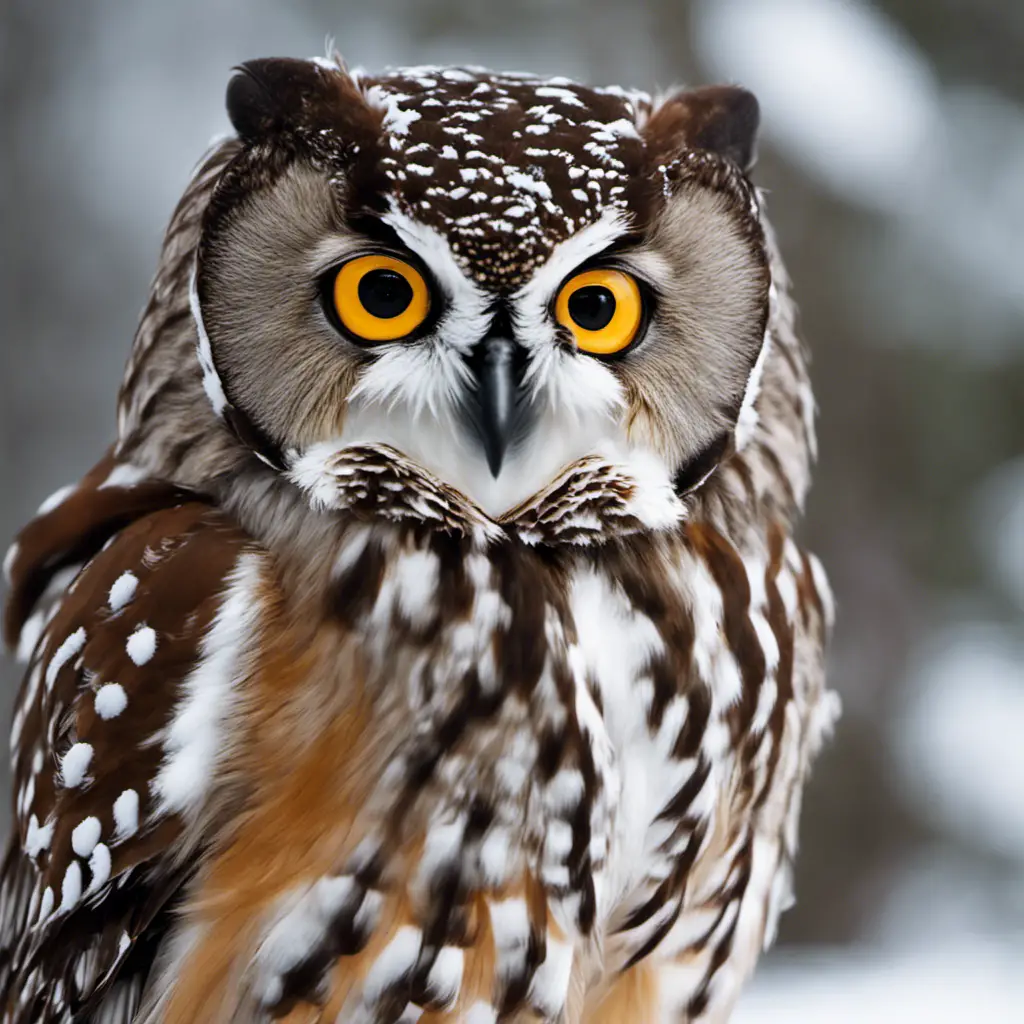
You can learn more about the unique characteristics and habitat preferences of the boreal owl by researching reputable sources and observing their behavior in the wild.
The boreal owl, also known as the Tengmalm’s owl, is a small owl species that’s found in North America and Eurasia. It’s known for its round face, dark eyes, and distinctive feather pattern.
Conservation efforts for this species focus on protecting its preferred habitat, which includes coniferous forests and mixed woodlands. These owls rely on these habitats for nesting, roosting, and hunting.
Great gray owl
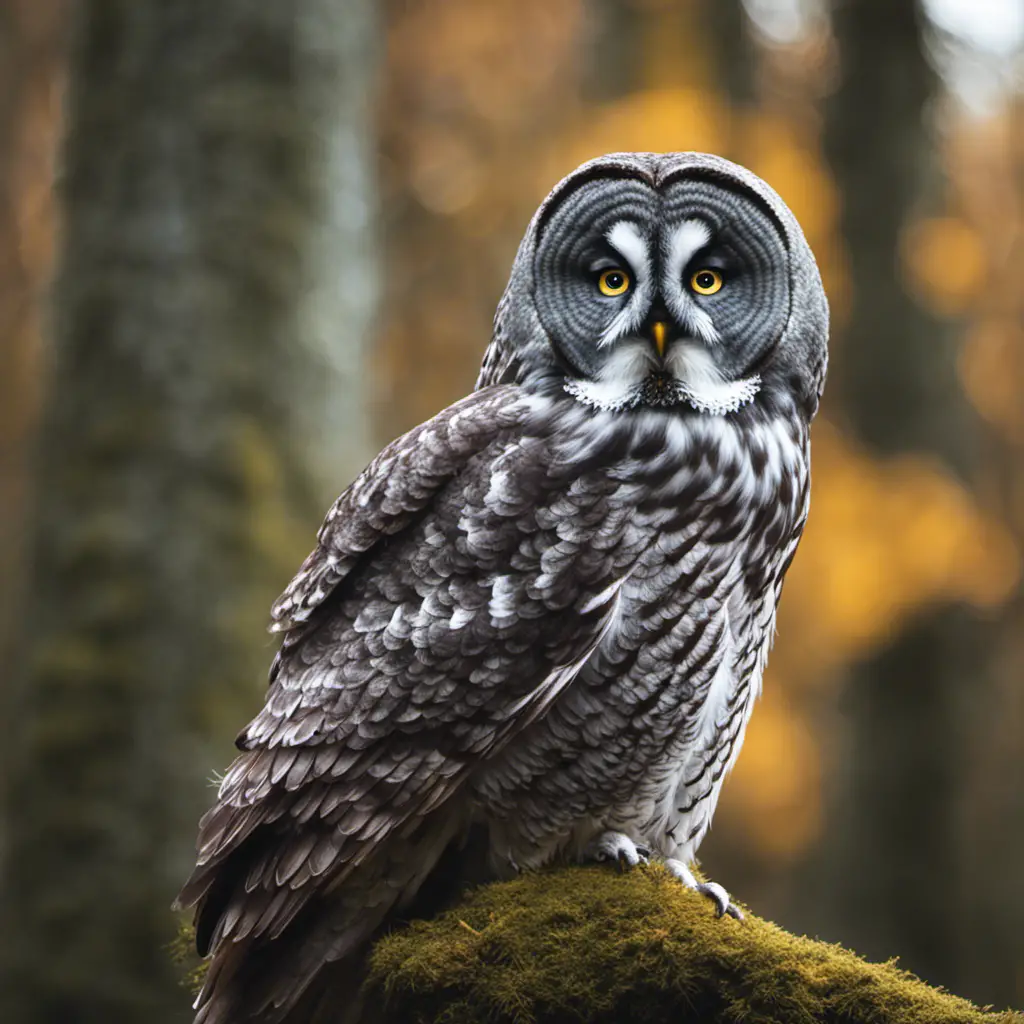
To learn more about the Great gray owl, you can research reputable sources and observe their behaviors in their natural habitat.
The Great gray owl, also known as Strix nebulosa, is a large owl species found in the northern parts of North America, Europe, and Asia. They’re known for their impressive size, with a wingspan of up to 60 inches and a weight of around 2.2 pounds.
These owls primarily inhabit dense forests and coniferous woodlands, where they build their nests on tree branches. They’re primarily nocturnal predators, feeding on small mammals such as mice and voles.
Conservation efforts for the Great gray owl focus on preserving their habitat and protecting their nesting sites. Efforts are also being made to reduce deforestation and ensure sustainable forestry practices, as these activities can significantly impact the owl’s population.
Flammulated owl
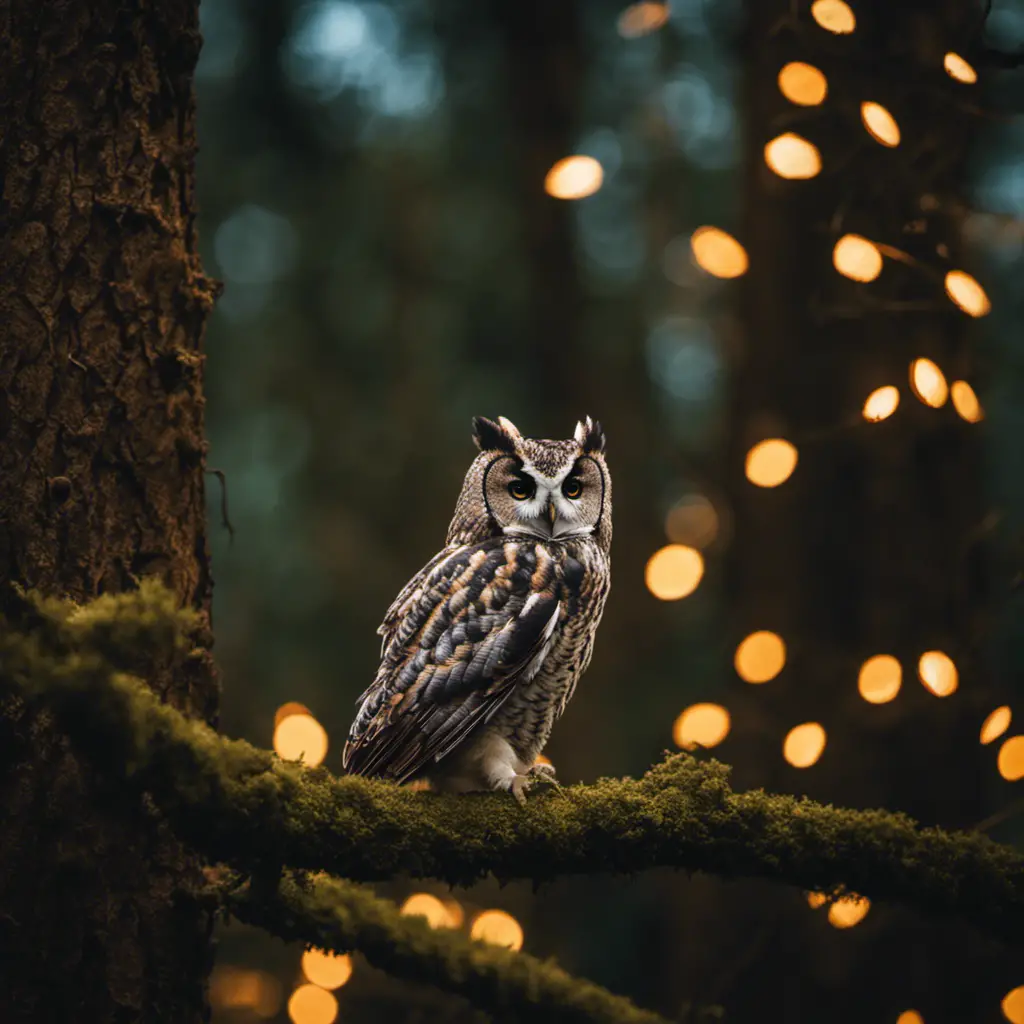
Spotting a flammulated owl in the wild can be an exciting and rare experience. Conservation efforts have been put in place to protect this species, which is known for its small size and unique appearance.
Flammulated owls are primarily found in the western parts of North America, preferring to inhabit dense coniferous forests at higher elevations. They’re nocturnal creatures, actively hunting for insects during the night. These owls have distinct behaviors, such as their ability to camouflage themselves within the tree bark, making them difficult to spot.
Their preferred habitats provide them with ample opportunities to find food and suitable nesting sites. Through ongoing conservation efforts, the goal is to preserve the flammulated owl’s habitat and ensure their population remains stable for future generations to experience their beauty in the wild.
Western screech-owl
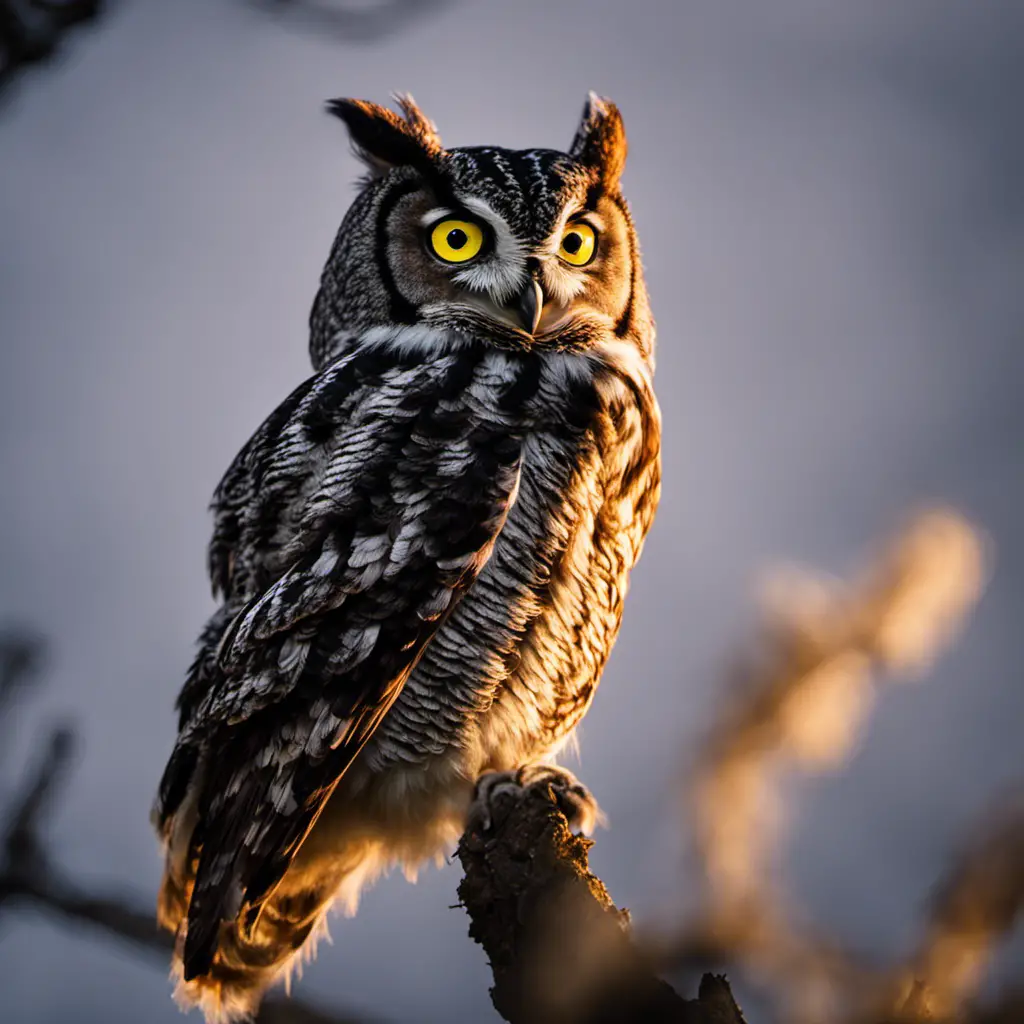
If you’re interested in owls, you’ll be fascinated to learn that the Western screech-owl is a small owl species native to western North America. These owls are known for their distinctive call, which sounds like a trilling whinny. They’ve excellent camouflage, with gray or reddish-brown plumage that helps them blend in with tree bark. Western screech-owls are primarily found in wooded habitats, including forests, canyons, and riparian areas. They prefer to nest in tree cavities or use abandoned woodpecker holes.
Breeding behavior of Western screech-owls is quite interesting. They typically form monogamous pairs and breed once a year. The female lays a clutch of 2-4 eggs, which she incubates for about a month. Both parents take turns hunting for food and caring for the chicks. Once the chicks hatch, they stay in the nest for several weeks before they’re able to fly and become independent. Western screech-owls are skilled hunters, feeding on a variety of small prey including mice, birds, and insects.
Whiskered screech-owl
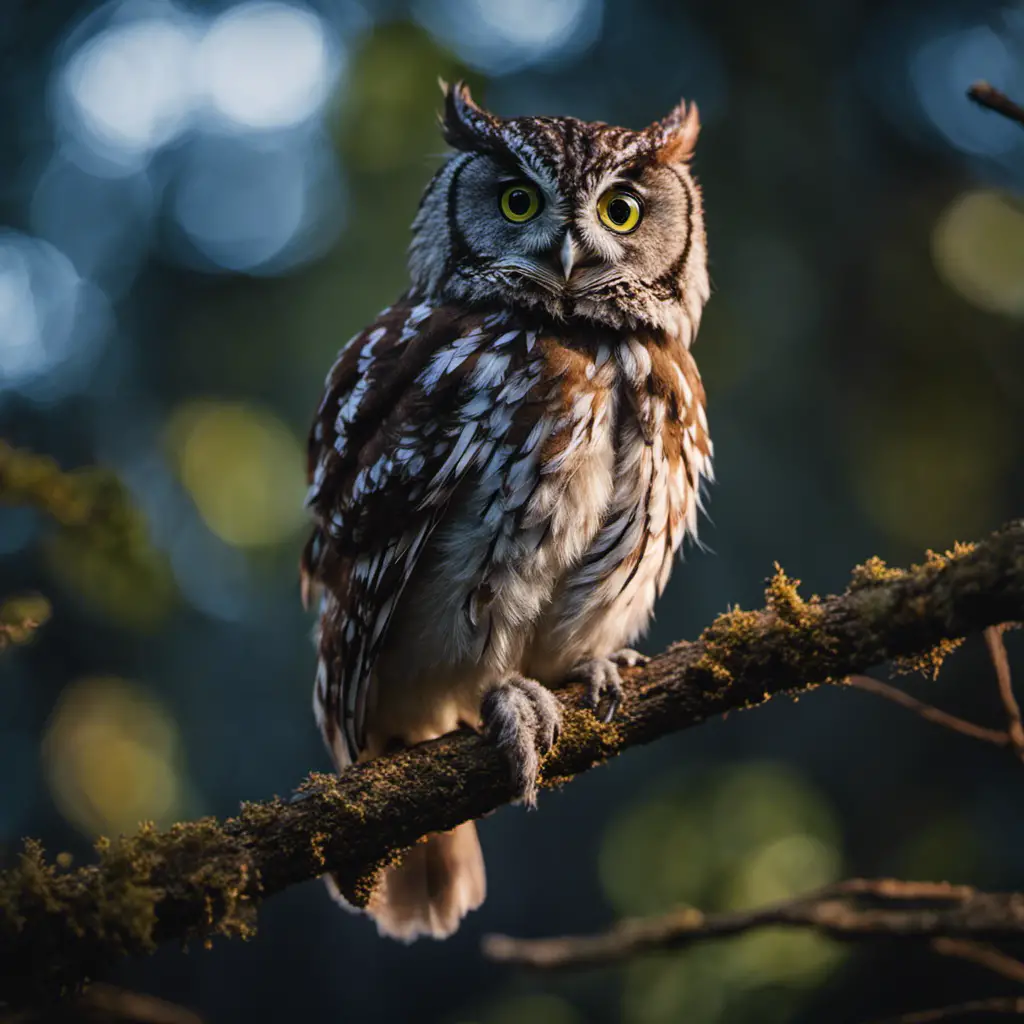
Have you ever seen a Whiskered screech-owl in person, or do you only know about them from pictures and videos? These small owls, scientifically known as Megascops trichopsis, can be found in certain regions of North and Central America. They inhabit a variety of habitats including deciduous and mixed forests, as well as desert canyons. Whiskered screech-owls are primarily nocturnal, using their keen hearing and excellent camouflage to hunt for insects, small mammals, and birds. They’ve distinct whisker-like feathers around their beaks, which aid in their hunting abilities.
Conservation efforts for the Whiskered screech-owl are focused on protecting their natural habitats from deforestation and urbanization. Monitoring population trends is also crucial in understanding the health of their populations. Unfortunately, due to habitat loss and fragmentation, the population of Whiskered screech-owls is declining in some areas. It’s important for researchers and conservationists to continue studying and implementing conservation measures to ensure the survival of this unique species.
Mexican spotted owl
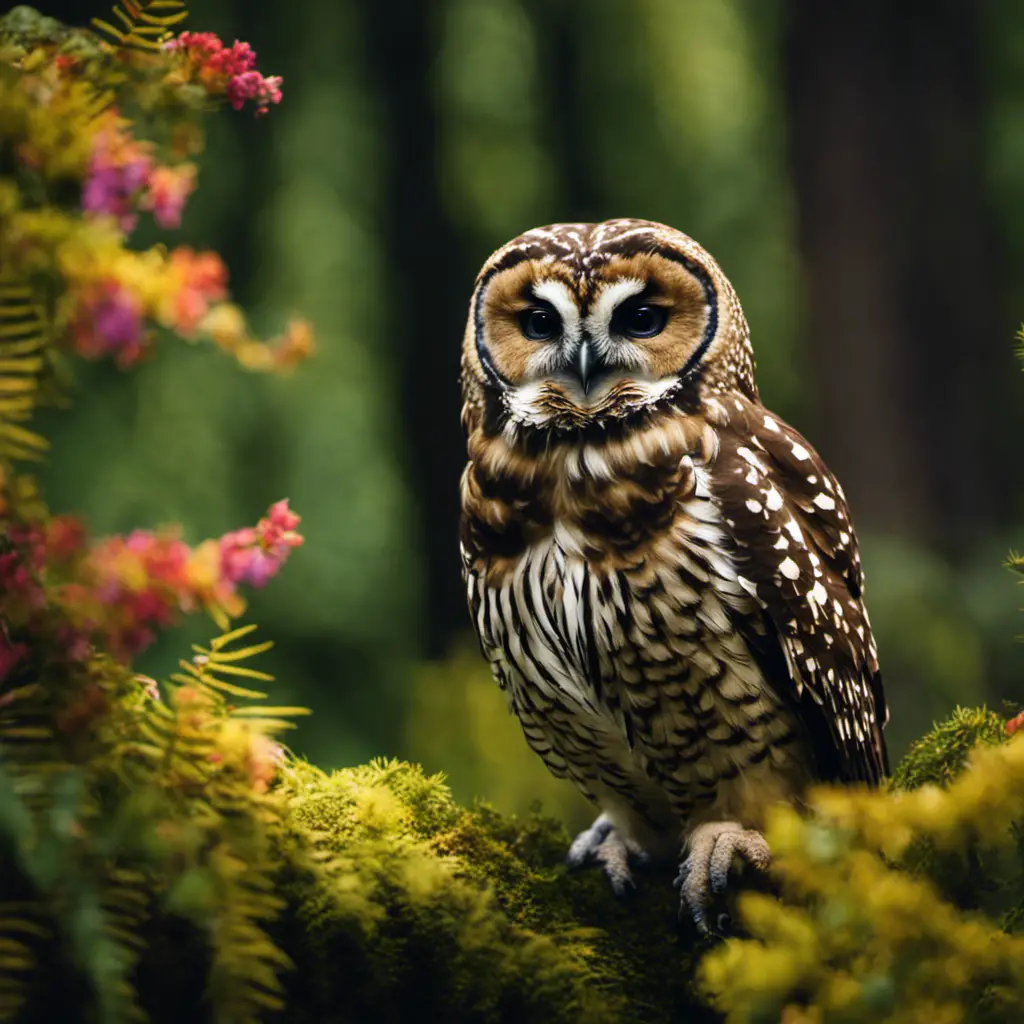
You should learn more about the Mexican spotted owl, as it’s an endangered species that relies on old-growth forests for its survival. This owl is found in the southwestern United States and Mexico, specifically in areas with dense, mature forests.
Conservation efforts are crucial for the protection of this species, as its habitat is being rapidly destroyed due to logging, wildfires, and urbanization. The Mexican spotted owl plays an important role in the ecosystem as a top predator, helping to control populations of small mammals and birds.
To ensure the survival of this species, it’s necessary to implement measures that prioritize the preservation and restoration of its habitat, including the protection of old-growth forests and the prevention of habitat destruction.
Spotted owl
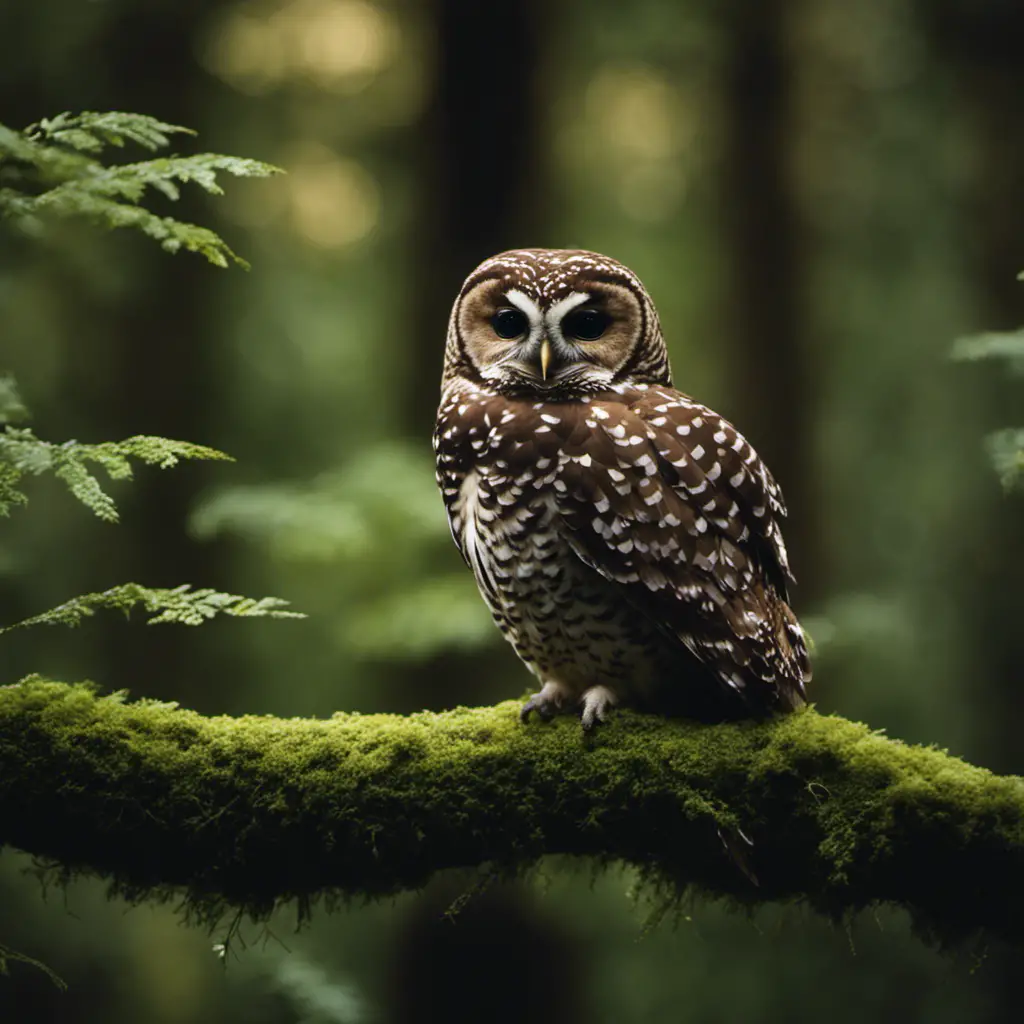
Surely, you must be aware that the spotted owl is a key indicator species for the health of old-growth forests, and its declining population is a cause for concern.
Conservation efforts and habitat preservation are crucial to ensuring the survival of this magnificent bird.
The spotted owl relies on mature forests with complex vegetation structures for nesting, roosting, and hunting. However, due to logging and habitat fragmentation, their habitat has been greatly reduced.
As a result, the population of spotted owls has declined significantly in recent years.
To address this issue, conservation organizations and government agencies are working together to protect and restore old-growth forests, establish protected areas, and implement sustainable logging practices.
These efforts aim to provide the spotted owl with suitable nesting sites, ample prey, and interconnected habitats to facilitate their population recovery.
Northern hawk-owl
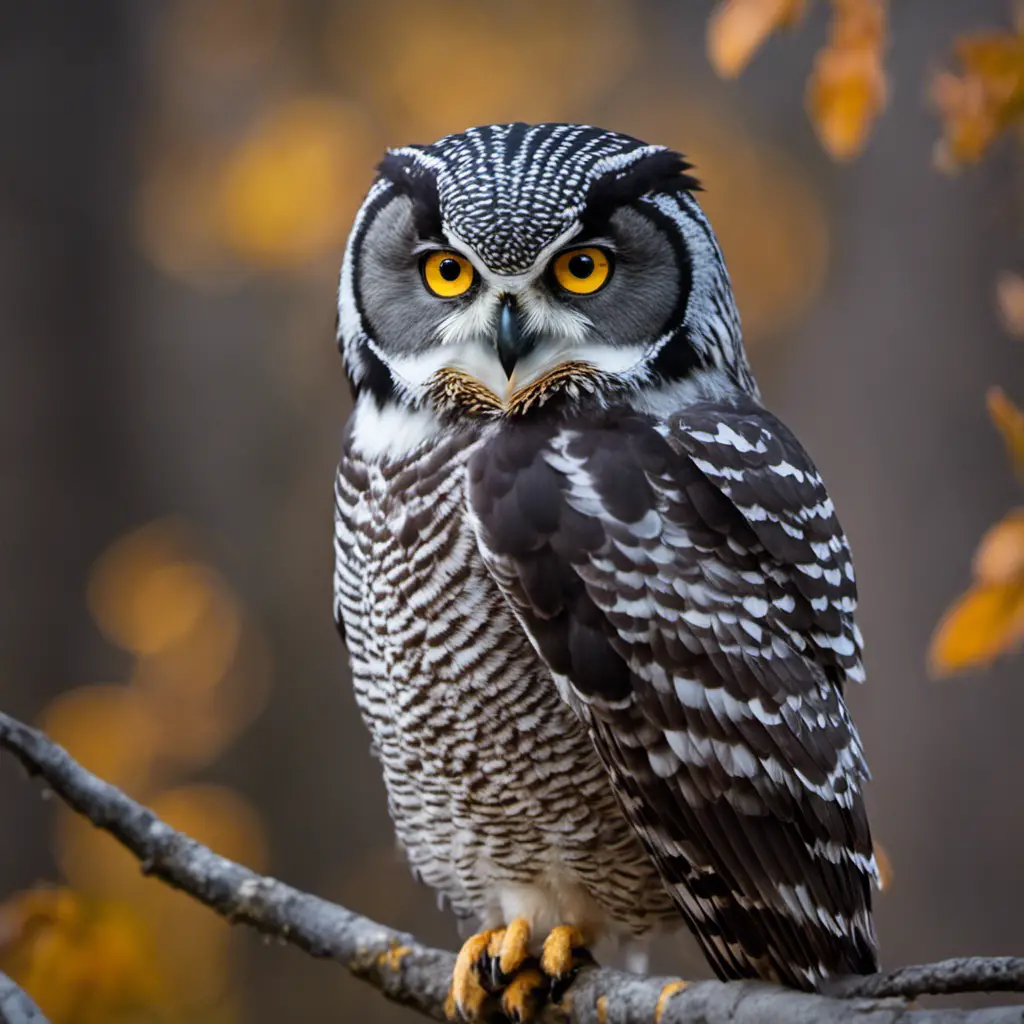
There are several subspecies of the Northern hawk-owl, each with unique characteristics and distributions. These owls are found in the northern regions of North America, Europe, and Asia. They’re known for their distinct hawk-like appearance and behavior, with long tails, short wings, and fierce hunting abilities.
Northern hawk-owls have behavioral adaptations that enable them to thrive in their habitats. Some of these adaptations include their ability to perch high in trees to scan for prey, their exceptional hearing that allows them to locate small mammals and birds in the dark, and their silent flight that aids in surprise attacks.
In terms of habitat preferences, these owls typically inhabit dense coniferous forests, where they can find suitable nesting sites and prey abundance. They’re also known to adapt to open areas, such as meadows or tundra, during the breeding season.
Ferruginous pygmy-owl
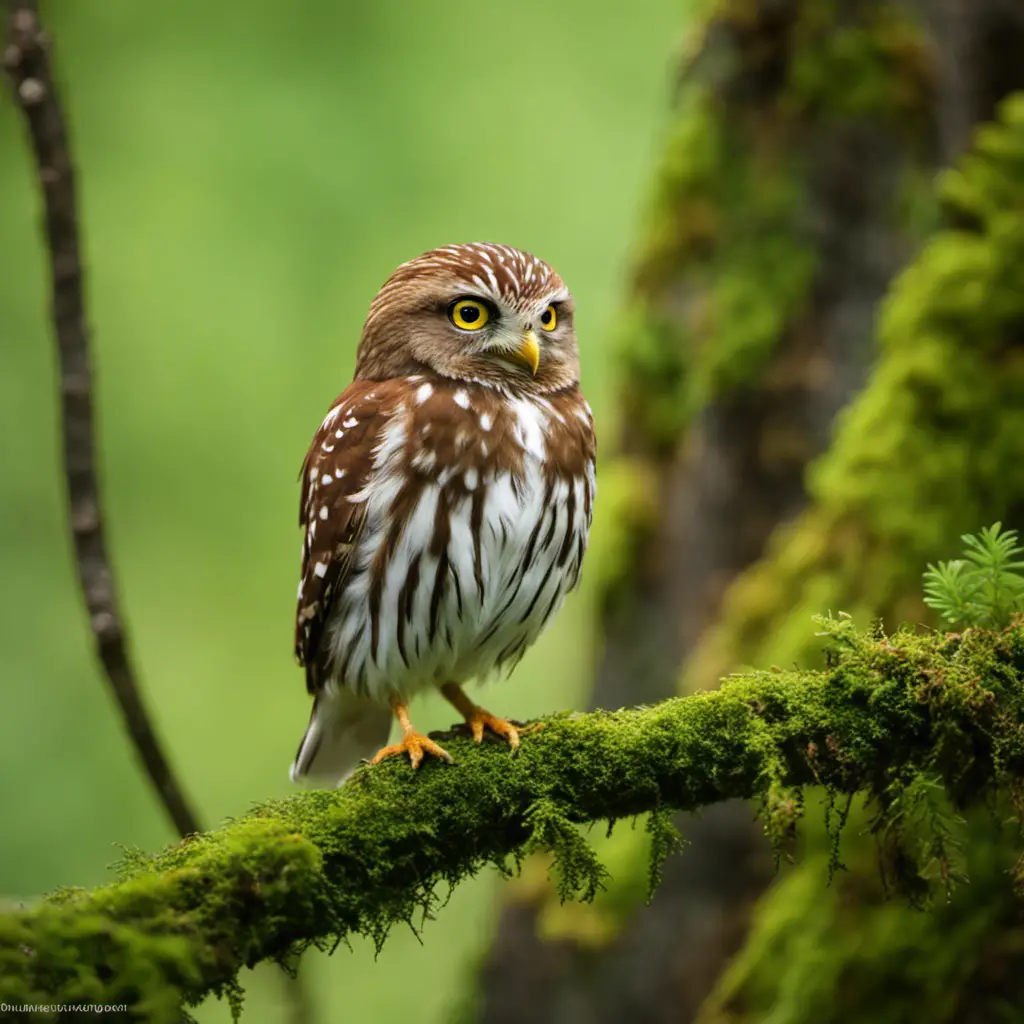
The Ferruginous pygmy-owl is a small owl species that’s native to the southwestern United States and Mexico, and it’s known for its distinctive rust-colored plumage.
Currently, the discussion revolves around the presence of owls in Ohio, specifically looking at the conservation efforts and habitat preferences of the Ferruginous pygmy-owl.
Conservation efforts play a crucial role in protecting this owl species and ensuring its survival. Ohio, although not their natural habitat, has seen occasional sightings of Ferruginous pygmy-owls.
These owls prefer open woodlands, forests, and areas with a mix of trees and grasslands. It’s important to understand their habitat requirements to identify potential areas for conservation and to implement measures that promote the preservation of suitable habitats for these owls.
Elf owl
You might be surprised to learn that there are actually six different species of owls in Ohio, including the elf owl. Ohio is home to a diverse population of owls, each with its own unique characteristics and behaviors.
Owls are fascinating creatures, known for their exceptional hunting abilities and their association with wisdom and knowledge. Owls are highly skilled nocturnal predators, relying on their excellent night vision and acute hearing to locate and capture their prey. They have adapted to their nocturnal lifestyle by developing specialized feathers that enable silent flight, allowing them to approach their prey undetected.
Owls have long been symbols of wisdom and knowledge in various cultures around the world, often depicted as wise and mystical creatures. These magnificent birds play a crucial role in maintaining the balance of the ecosystem, controlling populations of rodents and other small animals.
Understanding and appreciating these remarkable creatures can deepen our connection to the natural world and inspire us to protect their habitats.
Mottled owl
You might want to know that Ohio is home to not just one, but actually six different species of owls, including the mottled owl.
The mottled owl, also known as the barred owl, is a medium-sized owl with distinct brown and white bars on its chest. Its behavior patterns are fascinating to observe.
Mottled owls are mainly active during the night, hunting small mammals, birds, and amphibians. They’ve excellent hearing and can locate their prey by listening to their movements.
In terms of conservation efforts, mottled owls face threats such as habitat loss and collisions with vehicles. Efforts are being made to protect their habitats and raise awareness about the importance of preserving their populations.
Spectacled owl
There are several owl species in Ohio, including the spectacled owl, which is known for its distinctive markings and large, piercing eyes. The spectacled owl (Pulsatrix perspicillata) is a medium-sized owl species that can be found in the tropical rainforests of Central and South America. It has a wingspan of approximately 42-46 inches and weighs around 2-3 pounds.
Conservation efforts for the spectacled owl are crucial due to the destruction of its natural habitat. Deforestation and land development have resulted in the loss of suitable nesting sites and prey availability. Efforts are being made to protect and restore these habitats to ensure the survival of this species.
Habitat and behavior analysis have provided valuable insights into the spectacled owl’s preferred environments and hunting techniques. They primarily inhabit dense, mature forests and are known for their ability to perch silently and patiently for hours, waiting for prey to pass by. They primarily feed on small mammals, birds, and reptiles.
Crested owl
Have you ever seen a crested owl? They’re known for their distinctive crests on their heads and can be found in various regions across the world.
Crested owls are primarily found in tropical rainforests, where they inhabit the upper canopy layers. They prefer dense, undisturbed forests with a rich diversity of prey species.
In terms of mating behavior, crested owls are monogamous and form long-term pair bonds. During courtship, the male will display his crest and engage in elaborate vocalizations to attract a female.
Conservation efforts for crested owls focus on protecting their habitat from deforestation and preserving their prey base. Unfortunately, the population trends of crested owls are declining due to habitat loss and fragmentation.
It’s crucial to continue conservation efforts to ensure the survival of these magnificent birds.
Tawny owl
If you’re interested in owls, you might find it fascinating to learn about the habits and characteristics of the tawny owl. The tawny owl, scientifically known as Strix aluco, is a medium-sized owl species found in various habitats across Europe, Asia, and North Africa.
Here are some key points about the tawny owl’s habitat preferences and breeding behavior:
Habitat preferences:
Tawny owls are adaptable and can be found in a range of habitats including woodlands, forests, parks, and gardens.
They prefer mixed woodlands with dense vegetation for nesting and roosting.
Tawny owls are often associated with old trees that provide suitable nesting sites.
Breeding behavior:
Tawny owls are monogamous and form lifelong pair bonds.
Breeding season typically starts in late winter or early spring.
They build nests in tree cavities or use abandoned nests of other birds.
Understanding the habitat preferences and breeding behavior of the tawny owl helps us appreciate their ecological role and conservation needs.
Eurasian eagle-owl
You can spot the Eurasian eagle-owl in various regions of Europe and Asia, thanks to its adaptability and preference for woodlands and rocky habitats.
This magnificent bird, also known as Bubo bubo, is one of the largest owl species in the world, with a wingspan reaching up to 6 feet. Its conservation status is of concern due to habitat loss and illegal hunting. However, conservation efforts have been implemented to protect this majestic creature.
The Eurasian eagle-owl possesses unique adaptations that aid in its survival. Its large, powerful talons allow it to capture and kill prey, while its silent flight enables it to sneak up on unsuspecting victims. Furthermore, its excellent eyesight and hearing make it an efficient nocturnal hunter.
Frequently Asked Questions
What Is the Habitat Range of the Owls Found in Ohio?
The habitat range of owls in Ohio depends on the specific species. Factors such as food availability, nesting sites, and climate influence their distribution. Conservation efforts aim to protect and restore suitable habitats for these magnificent birds.
How Do Owls in Ohio Differ in Appearance and Size?
Owls in Ohio differ in appearance and size due to various factors such as species and age. They exhibit diverse behaviors and nesting habits, which contribute to their unique characteristics.
Are Any of These Owl Species in Ohio Endangered or Threatened?
In Ohio, some owl species may be endangered or threatened. Conservation efforts are in place to protect them. It is important to ensure the survival of these owls and maintain their habitats.
What Is the Diet of the Different Owl Species in Ohio?
The diet of different owl species varies depending on their foraging habits. Owls are known to consume a wide range of prey, including rodents, birds, insects, and small mammals.
Can Owls in Ohio Be Found in Urban Areas or Are They Strictly Found in Rural Regions?
Urban owl sightings in Ohio are possible as owls are adaptable and can thrive in a variety of habitats. While they are more commonly found in rural regions, their nocturnal behavior allows them to explore urban areas for food and shelter.
Conclusion
In conclusion, Ohio is home to a diverse range of owl species. The Eastern screech-owl, Barred owl, Great horned owl, Long-eared owl, Short-eared owl, Spectacled owl, Crested owl, Tawny owl, and Eurasian eagle-owl all inhabit this region.
Each species possesses unique characteristics and adaptations that enable them to thrive in their respective habitats. Studying these owls provides valuable insights into the ecological dynamics of Ohio’s ecosystems and contributes to our understanding of avian diversity in the state.

An avid ornithologist, zoologist and biologist with an unwavering passion for birds and wild animals.
Dr. Wilson’s journey in ornithology began in childhood and led him to obtain a Ph.D. in Ornithology from the prestigious Avian Research Institute. He has worked closely with renowned experts in the field and conducted extensive research and field studies globally.

